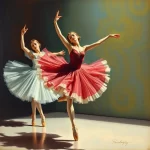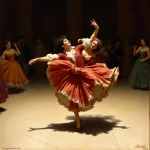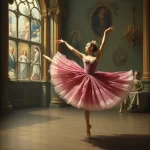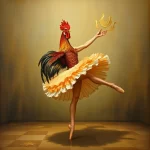Ballet: Le Chant du rossignol (Igor Stravinsky, 1920)

Introduction
Ballet, as an art form, has always been a confluence of music, dance, and storytelling. One of the most intriguing works in this genre is “Le Chant du rossignol” (The Song of the Nightingale), a ballet composed by Igor Stravinsky in 1920. This ballet, choreographed by Léonide Massine, premiered on February 2, 1920, at the Théâtre National de l’Opéra in Paris. The ballet is based on Hans Christian Andersen’s fairy tale “The Nightingale,” and it explores themes of nature versus artificiality, the power of art, and the transient nature of life.
Historical Background
Creation and Development
“Le Chant du rossignol” was created during a period of significant artistic and social change. The early 20th century was marked by the aftermath of World War I, which had a profound impact on the arts. There was a shift towards modernism, with artists seeking new forms of expression. Stravinsky, already a prominent figure in the world of music, was influenced by these changes and sought to create works that broke away from traditional forms.
The inspiration for the ballet came from Andersen’s fairy tale “The Nightingale,” which tells the story of an emperor who prefers the artificial song of a mechanical bird over the natural song of a real nightingale. Stravinsky had initially composed a symphonic poem based on this tale in 1914, but he later adapted it into a ballet. The collaboration between Stravinsky and Massine, along with the involvement of Sergei Diaghilev’s Ballets Russes, was crucial in bringing this work to life.
Premiere and Reception
The ballet premiered on February 2, 1920, at the Théâtre National de l’Opéra in Paris. The initial reception was mixed; while some critics praised the innovative music and choreography, others found it difficult to understand. However, the ballet gained recognition over time, with notable early performances and revivals helping to cement its place in the ballet repertoire.
Synopsis of the Ballet
“Le Chant du rossignol” is a one-act ballet that unfolds in a series of scenes, each depicting a different aspect of the story.
Detailed Summary
The ballet opens with the Emperor of China discovering the beautiful song of a nightingale. The nightingale’s song brings joy and peace to the Emperor, who invites the bird to stay in his court. However, the arrival of a mechanical nightingale, which can sing on command, leads the Emperor to neglect the real nightingale. The mechanical bird eventually breaks down, and the Emperor falls gravely ill. In his time of need, the real nightingale returns, and its song restores the Emperor’s health. The ballet concludes with the Emperor realizing the true value of the natural nightingale’s song.
Musical Composition
Composer’s Role
Igor Stravinsky, one of the most influential composers of the 20th century, played a pivotal role in the creation of “Le Chant du rossignol.” His innovative use of orchestration and rhythm brought a new dimension to the ballet. Notable pieces within the score include the “Chinese March,” “Song of the Nightingale,” and “The Mechanical Nightingale.”
Musical Themes and Motifs
The music of “Le Chant du rossignol” is characterized by its use of recurring themes and motifs. The natural nightingale’s song is represented by a lyrical and flowing melody, while the mechanical bird’s song is depicted through rigid and repetitive patterns. These musical contrasts enhance the narrative and emotional depth of the ballet.
Famous Recordings and Performances
Several iconic recordings of the ballet’s music have been made, including performances conducted by Stravinsky himself. These recordings have helped to preserve and popularize the ballet’s score, making it accessible to a wider audience.
Choreography and Dance
Choreographer’s Vision
Léonide Massine’s choreography for “Le Chant du rossignol” was innovative and reflective of the modernist trends of the time. Massine sought to capture the essence of the story through expressive movements and intricate patterns. His interpretation emphasized the contrast between the natural and artificial elements of the tale.
Signature Dance Numbers
Key dance numbers in the ballet include the “Dance of the Nightingale,” which showcases the grace and beauty of the natural bird, and the “Mechanical Bird Dance,” characterized by its precise and mechanical movements. These dances not only reflect the story but also highlight the technical prowess of the dancers.
Notable Interpretations
Over the years, different productions have brought their own interpretations to the choreography of “Le Chant du rossignol.” Some have emphasized the fairy tale aspect, while others have focused on the modernist elements. These variations have kept the ballet fresh and relevant for contemporary audiences.
Characters and Roles
Main Characters
- The Emperor: The ruler of China who learns to appreciate the true value of the nightingale’s song.
- The Nightingale: A symbol of natural beauty and art, whose song has the power to heal.
- The Mechanical Nightingale: A representation of artificiality and the limitations of man-made creations.
Supporting Characters
- The Courtiers: Members of the Emperor’s court who initially favor the mechanical bird.
- The Fisherman: A character who introduces the nightingale to the Emperor.
Famous Dancers
Notable dancers who have portrayed these roles include Serge Lifar as the Emperor and Tamara Karsavina as the Nightingale. Their performances have left a lasting impact on the interpretation of these characters.
Cultural and Artistic Impact
Influence on Ballet and Dance
“Le Chant du rossignol” has had a significant influence on ballet and dance. Its innovative choreography and music have inspired other works and choreographers. The ballet’s exploration of themes such as nature versus artificiality has also resonated with audiences and artists alike.
Cultural Significance
The ballet holds a special place in popular culture and has been referenced in literature, film, and other media. Its themes and story continue to be relevant, making it a timeless piece of art.
Legacy and Revivals
Major revivals and reinterpretations of “Le Chant du rossignol” have kept the ballet alive in the modern era. Companies such as the Royal Ballet and the Bolshoi Ballet have staged successful productions, ensuring that new generations of audiences can experience this masterpiece.
Iconic Productions
Historic Productions
One of the most famous historical productions was the original 1920 premiere by the Ballets Russes, featuring designs by Henri Matisse. This production set the standard for future interpretations and remains a landmark in ballet history.
Contemporary Productions
Recent productions have brought new perspectives to the ballet. For example, contemporary choreographers have experimented with modern dance techniques and multimedia elements to enhance the storytelling.
Production Design
The set, costume, and lighting design in various productions of “Le Chant du rossignol” have played a crucial role in bringing the story to life. From Matisse’s original designs to modern interpretations, the visual elements have always complemented the music and choreography.
Critical Reception and Reviews
Initial Critical Response
The initial critical response to “Le Chant du rossignol” was mixed. While some praised its innovation, others found it challenging to understand. However, over time, the ballet gained recognition for its artistic merit.
Modern Reviews
Contemporary critics and audiences have come to appreciate the ballet’s complexity and beauty. Modern reviews often highlight the timeless nature of its themes and the brilliance of Stravinsky’s score.
Fun Facts and Trivia
Behind-the-Scenes Stories
One interesting anecdote from the production is that Stravinsky initially composed the music as a symphonic poem before adapting it into a ballet. This transition required significant collaboration with Massine and Diaghilev.
Notable Performers
Famous dancers such as Serge Lifar and Tamara Karsavina have left their mark on the ballet, bringing their unique interpretations to the roles.
Trivia
- The original designs for the ballet were created by Henri Matisse, adding a unique visual element to the production.
- Stravinsky himself conducted several performances of the ballet’s music, adding his personal touch to the interpretation.
Conclusion
Summary of the Ballet’s Importance
“Le Chant du rossignol” is a significant work in the world of ballet, combining innovative music, choreography, and storytelling. Its exploration of themes such as nature versus artificiality and the power of art continues to resonate with audiences.
Final Thoughts
The ballet remains a testament to the collaborative efforts of Stravinsky, Massine, and Diaghilev. It encourages viewers to appreciate the beauty of natural art and the transient nature of life. For those who have not yet experienced it, watching a performance or listening to the score is highly recommended.
FAQ
What is the central theme of this ballet?
The central theme of “Le Chant du rossignol” is the contrast between natural beauty and artificiality, as well as the power of art to heal and transform.
Who are the main characters in this ballet?
The main characters are the Emperor, the Nightingale, and the Mechanical Nightingale.
What is the most famous dance number in this ballet?
The “Dance of the Nightingale” is one of the most famous dance numbers, showcasing the grace and beauty of the natural bird.
How long does a typical performance of this ballet last?
A typical performance of “Le Chant du rossignol” lasts approximately 30-40 minutes.
Are there any modern adaptations of this ballet?
Yes, there have been several modern adaptations that incorporate contemporary dance techniques and multimedia elements.
Why is this ballet considered important in the history of dance?
“Le Chant du rossignol” is considered important due to its innovative music, choreography, and exploration of timeless themes. It has influenced other works and continues to be celebrated in the world of ballet.





